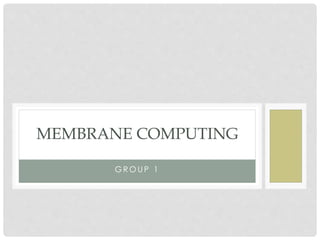
Membrane computing
- 1. G R O UP 1 MEMBRANE COMPUTING
- 2. WHAT IS COMPUTING ?
- 3. What is Computing ? Computing is any goal-oriented activity requiring, benefiting form, or creating algorithmic processes. Computing includes : Designing, developing and building hardware and software systems. Processing, structuring and managing various kinds of information. Doing scientific research on and with computers etc.
- 4. The models of computing -> Von Neuman Model (Instruction driven Model) : • Personal Computers, Laptops Pattern driven Model : • Artificial intelligence Data driven Model : • Machine learning, Soft Computing Natural Computing : • Molecular Computing, Quantum computing
- 6. What is Natural Computing ? Studying of the models of computation inspired by biological systems. Nature is a major source of inspiration; Natural phenomena can be translated into computing paradigms. Natural processes can be (and are) used as carriers of computational operations. The best thing is in natural computing, best solution emerge rather than being designed.
- 7. Some approaches in Natural Computing use the methods of formal language theory ; L-systems : • Development of multicellular organisms. (plants) • Founded by Aristid Lindenmayer in 1968. Cellular Automata: • Discrete model studied in Computability theory, Mathematics, Physics, Complexity science, Theoretical biology and Microstructure modeling. • Founded by Stephen Wolfram in 1983 based on the work of V. Neuman, Stanislaw Ulam. H-systems: • DNA • Founded by Tom Head in 1987. Membrane computing(P-systems): • Founded by Gheorghe Paun in 1998.
- 9. Membrane Computing “ The paradigmatic idea of membrane computing is to see whether we can mimic the living cell – its structure and functioning.” -Gheorghe Păun
- 10. What is Membrane Computing ? Challenges : Is a ‘living cell’ computing? Can we abstract a computing device from the cell structure and functioning ? How computationally powerful is this device? Is it possible to implement computations in living cells?
- 11. ‘Living cells’ have usually a large number of compartments hosting a huge variety of biochemical reactions. So a living cell is doing computations too. Membrane Computing[MC] is an area within computer science that seeks to discover new computational models from the study of the biological cells, particularly the cellular membranes. MC is a generalization of DNA computing: Within different regions of space different but not unrelated computations can be performed. MC is a branch of molecular computing initiated by ‘Gheorghe Paun’ in 1998.
- 12. Biologically inspired, but a computational rather than a biological model. MC identifiers an unconventional computer model called P-systems (abstracts from the way living cell process chemical compounds in their compartmental structure.) Membranes organized as Venn diagrams/tree structure where one membrane contains other membranes. Dynamics of the system governed by the set of rules associated with each membrane. Rules specify how objects evolve/move into neighboring membranes how membranes can dissolved/divided/created.
- 13. Rules are used in nondeterministic, maximal parallel manner define transition between configurations. A P-system can be used as : acceptor of configurations or generator of configurations. (from a fixed initial configuration)
- 14. Dynamics of P-systems : Each region contains a multi set of objects and a set of rules. The objects are represented by symbols from a given alphabet. We start with and initial configuration : An initial membrane structure and some initial multi set of objects placed inside the region of the system. We apply the rules in nondeterministic maximal parallel manner in each step, each region, each object that can be evolved according to some rule must do it.
- 15. A computation is said successful if it halts, that is , it reaches a configuration where no rules can be applied. The result of a successful computation may be the multi sets formed either by the object contained in a specific output membrane or by the objects sent out of the system during the computations. A non-halting computation yields no result.
- 16. Language acceptor/generator : A P-system ‘p’ starts with an initial configuration z= 1 𝑛1 𝑎 … … 𝑘 𝑛𝑘 𝑎 in the input membrane. At each step, a maximal multi sets of rules are non-deterministically selected and applied in parallel. The string ‘z’ is accepted if the system eventually halts. (a configuration is halting if no rule is applicable.) A string ‘w’ is generated if found in originally empty output membrane.
- 18. Applications of Membrane Computing Most of the applications of membrane computing use cell-like P systems and tissue-like P systems and the general protocol. General protocol is a P system written which models a given process, capturing the objects, compartments, and evolution rules. After that a program is written to simulate this P system. In this way, applications of membrane computing is can be separated into 04 categories. 1. Bio Applications 2. Computer Science Applications 3. Applications to Linguistics
- 19. Bio Applications 1) P system models for Mechanosensitive Channels. 2) P systems for Biological Dynamics. 3) Modeling respiration in Bacteria and Photosynthesis/Respiration. 4) Modeling call-meditated immunity by means of P-systems. 5) A membrane computing model on photosynthesis. 6) Modeling ‘P53’ pathway by using multi set processing.
- 20. Computer Science Applications 1) Static sorting P-systems. 2) Membrane based devices used in computer graphics. 3) An analysis of public key protocol with membranes. 4) Membrane algorithms. 5) Computationally hard problems addressed through P-systems. 6) Membrane computing software.
- 21. Application to Linguistics 1) Linguistics membrane systems. 2) Parsing with P-automata.
- 23. Membrane computing provides computational models that abstracts from the living cell structure and functioning. Such models have been proved to be computationally powerful and efficient. Membrane computing defines an abstract framework about distribute architectures communication parallel information processing. Such features are relevant both for computer science and biology. Membrane systems have been developed so far as a purely generative devices in the context of the formal language theory. They lack a well-defined semantics for reasoning about real systems. Non-determinism and maximal parallelism are not always desirable features.
